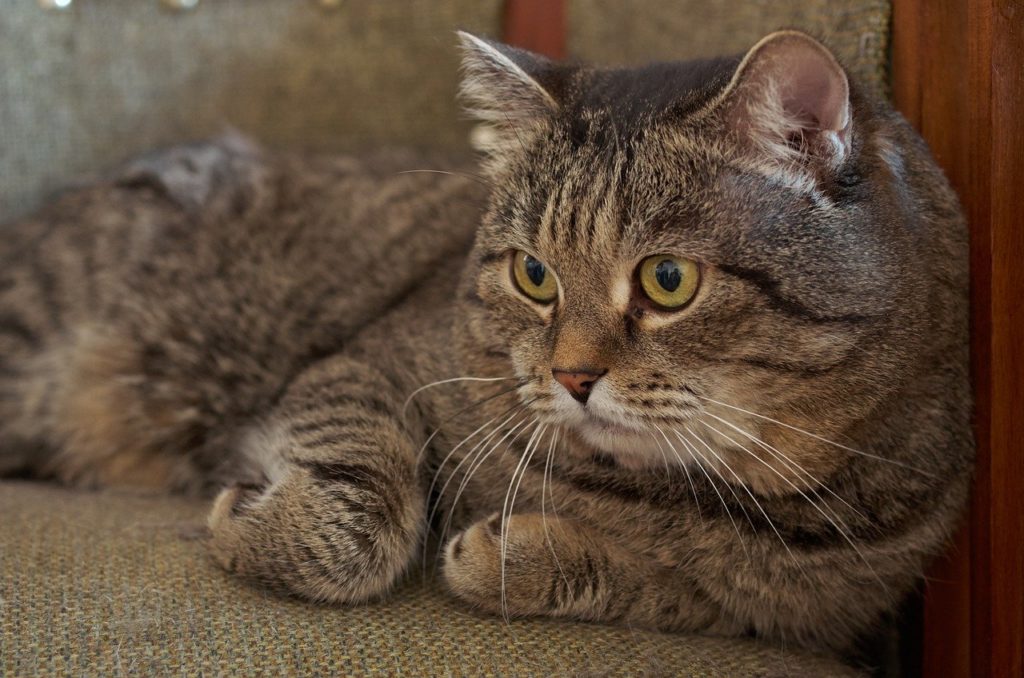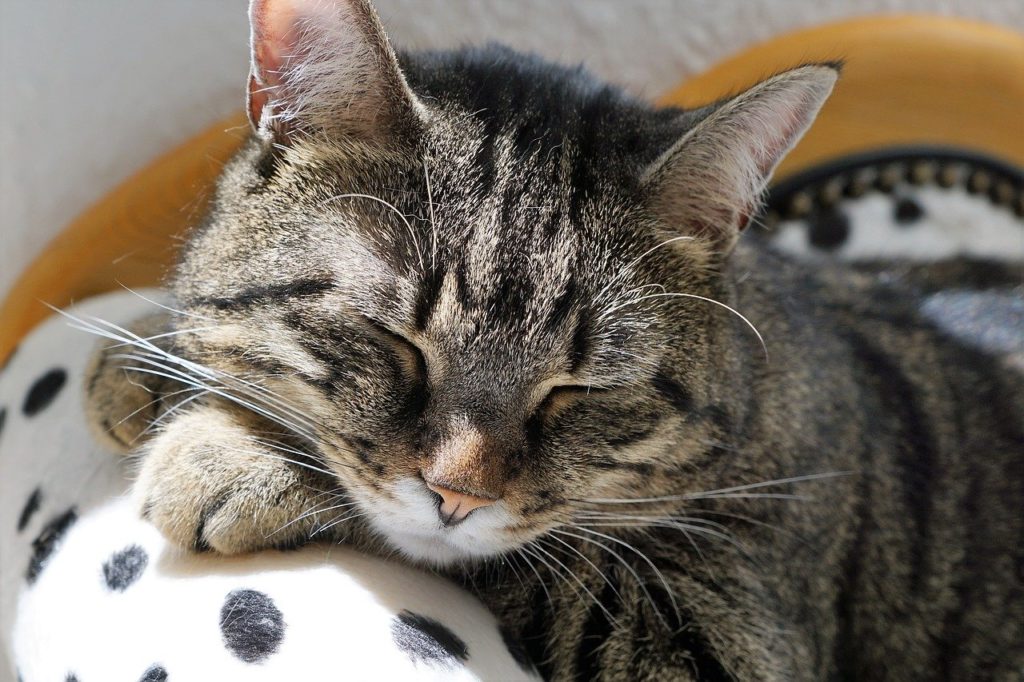You are concerned about the weight of your cat and suddenly you know the weight of a cat according to its age could help you. Indeed, without a growth chart, without reference grids or without a cat's weight curve, is it difficult to assess yourself if your cat is not a little too fat or downright too thin?
However, from its youngest age to its senior years, the weight of a cat changes throughout its life. And everyone knows that an extra pound or less can reveal health issues that could affect your cat's overall well-being, longevity, and quality of life.
So, I will explain to you how to know if a cat has a "normal weight", if it is not too thin or, from what weight a cat is obese ? For that, I will share with you some information and references on the weight of a tomcat throughout the different stages of its cat life.
Cat weight curve
It is impossible to determine the actual average weight of a cat because no cat is "average" and because each breed of cat is unique and has its own weight curves.
Indeed, the weight of a cat varies according to its breed, its age, its sex, its level of physical activity, its genes, its state of sterilization ... All these elements are too numerous and variable to calculate the average weight of a cat and to make a general curve of the cat's weight according to age.
On the other hand, there are indications on the average weights of adult cats (over 1 year old) according to the main breeds (see below).
Which cats are predisposed to gain weight?
According to statistics, the cats most at risk of weight gain are:
- Shorthair cats and mixed breed cats rather than pure breeds;
- Cats aged 5 to 10 who do not have sufficient physical activity;
- Male cats more than females;
- Castrated or neutered cats (see How to feed a sterilized cat?);
- Cats that are not fed properly (see How to feed a cat properly?);
- Indoor cats.

Average weight of a cat according to its breed
The information below corresponds to estimates, according to the main breeds of cats, of average weights for an adult cat and in good health :
- Alley cat type cats: Weight between 3 and 5 kg
- Abyssinian: Average weight between 2 and 4 kg
- Burmese: Average weight between 3 and 4,5 kg
- Devon Rex: Average weight between 3 and 5 kg
- Maine Coon: Average weight between 5 and 7 kg
- Persian: Average weight between 4 and 6 kg
- Sacred of Burma: Weight between 4 and 5 kg
- Siamese: Average weight between 3 and 5 kg
Cat's weight according to its age
To help you locate the your cat's weight in relation to his age, here are the main stages in the life cycle of cats and corresponding average weights.
These 6 stages of the cat's evolution from birth to the last years of life are characteristic of the majority of cat breeds.
Cat's weight from birth to 6 months
This is the 1st cat life cycle stage : This is the period when cats have the largest and fastest growing. They grow and grow considerably and regularly. See How to monitor the evolution of kittens' weight ?
When a kitten is born, its weight is usually between 90 to 110 grams. Kittens, if they are well fed and in good health, should grow by about 70 to 100 grams per week during the first two months of their life.
Here is an example of the estimated evolution of weight of a kitten less than 0 to 6 months old :
- Birth: From 90 to 110 g
- 1 week: From 140 to 200 g
- 2 weeks: From 180 to 300 g
- 3 weeks: From 250 to 380 g
- 4 weeks: From 260 to 440 g
- 5 weeks: From 280 to 530 g
- 6 weeks: From 320 to 600 g
- 7 weeks: From 350 to 700 g
- 8 weeks: From 400 to 800 g
- 3 months: From 1,2 kg to 2 kg
- 4 months: From 1,8 kg to 2,5 kg
- 5 months: From 2 kg to 3 kg
- 6 months: From 2,5 kg to 3,5 kg
Cat weight from 6 months to 2 years
This is the "JUNIOR" period: 2nd stage of the life cycle of cats.
During this long period, cats continue to grow and mature, but at a slower rate. See how to monitor the weight of kittens from 6 months?
This is the transition stage during which the kittens become adults. It is considered that theadulthood corresponds to the age of 1 year although for some large breeds adulthood is not reached until around 15 months or more.
Here is an example of the estimated evolution of the weight of a cat aged less than 6 months to 2 years :
- At 6 months: From 2,5 kg to 3,5 kg
- From 7 to 9 months: From 3 to 4 Kg
- From 9 to 12 months: From 3,5 to 5 Kg
- From 1 year to 2 years: From 3,5 to 5 Kg
For info, in France, it is between 6 months and 1 year that a kitten can be sterilized (see: At what age should a male cat be sterilized? ou At what age should a female kitten be sterilized?)
Cat's weight from 3 to 6 years old
This is the "ADULT" period: 3nd stage of the life cycle of cats.
At this point, cats are completely finished growing, are well established in their lives, and are generally in their prime.
Their weight is now stable:
- From 2 years to 6 years: Weight between 3,5 and 5 kg
Cat's weight from 7 to 10 years old
This is the "MATURE" period: 4nd stage of the life cycle of cats.
Just like humans, cats become less active as they age and are more prone to to gain weight and develop health problems such as kidney disease or diabetes.
- From 7 years to 10 years: Weight between 4 and 5,5 kg
During this period, you will need to be vigilant because your cat can quickly become obese (see below).
Cat's weight from 10 to 14 years old
This is the "SENIOR" period: 5nd stage of the life cycle of cats.
The lifespan of cats varies, but when they become older cats their health will generally deteriorate (See how do you know if your cat is sick?).
The human equivalent at this point is around 70 years old.
From 12-13 years old, unlike the adult cat who is more prone to getting fat, the senior cat is more often prone to weight loss. His muscle mass will gradually decrease and his appetite becomes more moderate. See my article: Cat too thin how to make it fat?
Cat weight 15 years and over
This is the "GERIATRIC" period: 6th and final stage in the life cycle of cats
Cats have an increasingly important longevity depending on their state of health and their lifestyle. According to scientific studies, the average life expectancy of a cat is between 12 and 15 years.
A 15-year-old cat equals a human age of 76.
From the age of 15, cats are therefore considered to be very old and may exhibit behavioral changes due to their age (incontinence, depression, etc.).
At the end of their life, cats tend to lose their appetite, have difficulty eating (loss of teeth) and lose weight.
Their health is seriously deteriorating and they need to be watched closely to detect when they are at risk of suffering. It will then be time to consult your veterinarian to know if it is necessary to consider euthanasia to avoid him enduring unnecessary suffering ...
Cat too big from what weight?
If your cat has grown a lot lately and you are wondering if he is obese or not, I recommend that you seek advice from his veterinarian.
In fact, veterinarians use a method to find out if a cat is at normal weight or not. They feel, measure and touch different places on the cat's body and refer to an evaluation table established according to the physical characteristics cats to determine if a cat is too skinny, normal, overweight or if your cat is obese.

How do you know if a cat is overweight or obese?
According to the publications that can be found on the internet, a cat is considered overweight when it exceeds 15 to 20% of its ideal weight and considered as obese when their weight is 30 to 40% above their reference weight.
But, as we saw earlier, there are many variables that affect a cat's weight. As a result, weighing your cat and comparing it to an “average weight” is not always accurate, reliable and revealing.
This is why, thanks to the indications in the table above, it will be better to check if your cat does not have a excess body fat noticeable by touch which is easier than trying to assess whether her weight is normal or not.
See my article: From what weight is a cat obese?
Obese cat risks
Excess fat has a negative impact on a cat's health and longevity. Indeed, studies prove that obese cats develop an increased risk of:
- many cancers,
- diabetes,
- heart disease,
- hypertension,
- osteoarthritis and faster degeneration of the affected joints,
- calculations,
- anesthetic complications ...
Obese cat what to do?
Once you have noticed that your cat is overweight or obese, it is important to adapt his diet according to his weight loss, using an adapted food, a ration and a specific meal frequency ...
See my article: Diet to lose weight for your obese cat
Do you want to know at what age your cat will settle down? So find out: At what age does a cat become calm?


Ping: How to feed a cat? When, how much and how to feed it?
Ping: How to feed a hungry cat - How to regulate a gluttonous cat?
Ping: Cat too skinny what to do - How to make a cat fat
Ping: Fatal Kitten Disease - How Do You Know If A Kitten Is Sick?